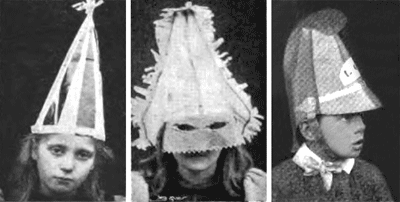Victorian Christmas Crackers
![The Christmas cracker is inseparable from a traditional Victorian Christmas. [Victoriana Magazine]](images/christmascrackers.jpg) |
|
If there is one thing inseparable from a traditional Victorian Christmas, it is — the Christmas cracker. The original crackers were love tokens; neither more nor less. They were simply bits of twisted and fringed colored tissue paper, with a sweet and a little verse inside; and they were called "Kisses." The French were the first to have these, and called them "bon-bons," but the fashion soon spread to England. At this time, Christmas crackers were about six inches long and comparatively plain. As a matter of fact they could hardly have been designated "crackers," for they did not "crack." |
|
|
|
 |
|
After a time people thought they could improve upon these "kisses," so they took fancier colored paper and put the sweet in the middle of a piece of paper—which was rather longer than it was broad—and gave it a twist near each end. The next improvement was to add the firework part, or "snap" as it is was called. It was also found that the twisting of the paper could be much more quickly and tightly done with a string than with the fingers. At this time—that is, after the firework part was added — the French called them "cosaques," possibly because the noise of the explosion reminded them of the sudden sharp gun shots of the Cossack soldiers. |
|
 |
|
In the early days each confectioner bought his own materials and made his own crackers. Tom Smith & Co., of Wilson Street, Finsbury, was the first company to start manufacturing crackers in England and the major mass producer of the Christmas cracker in late Victorian England. In 1891, they manufactured nearly eleven million in a single season. The Victorian Christmas cracker in its finer form of crimson and gold and cream and silver is an English holiday tradition that has presented many moments of merriment for generations. |
|
 |
|
For young children, the cracker prompted a delightful look of expectation as they waited for it to go "bang" and an eager cry as they scrambled after the surprise which came in response to the explosion. After they reveled in a complete outfit in the way of paper garments, hats and caps, jewels, toys, puzzles, and what not. During the nineteenth century, there were others who loved the cracker. The Christmas cracker offered a quaint ritual for courting … "she was delightfully eighteen and he with just enough moustache to twirl." The prospective twosome would each seize an end of that colorfully decorated cracker— "bang" it went. But the young Victorian girl and young man did not rush to pick up the gaily decorated paper caps; instead their target was the tiny slip of paper inside, and they were eager to read it. That little scrap of paper could say: |
|
|
|
The next moment they would be in the quietest corner of the room. It was Cupid himself who hopped out of that cracker. |
|
 |
|
| How to Make Christmas Crackers. Instructions and pictures here. | |
 |
|
Victorian Christmas crackers were filled with all sorts of trinkets and surprises – first they contained rhymed mottoes or verses, then some sort of fancy-paper hat, bonnet, mob-cap or masks. Considerable artistic talent was introduced in the adornment of these novelties. For instance, the "Silhouette" crackers were illustrated with black figures, comprising portraits of well-known characters in the political, military and social world. In addition, designs were adapted to other assortments, such as "Cameos," "Bric-a-brac," ''Musical Toys," each filled with appropriately themed trinkets. In addition, each year brought its own special set of novelties. In 1896, for instance, South African crackers containing miniature Gatling guns, tiny natives, and portraits of Dr. Jim, Cecil Rhodes, and other South African celebrities, were all the rage. The next year, their place was usurped by “Nansen" crackers, with polar bear masks, tiny thermometers, portraits of the explorer, and miniature balloons. |
|
 |
|
Tiny pill boxes with rouge and powder, faded flowers, a night cap, a wedding ring and a bottle of hair dye were in “Crackers for Spinsters.” One novel box featured a doll placed in the box, with a group of crackers each with some article of clothing inside, so that when every cracker was “pulled” the doll would be provided with a complete outfit. Many Christmas crackers, especially the more costly ones, were intended for table decoration rather than for amusement and were ornately decorated. No motto was ever used twice in the same box of crackers. One of the largest crackers manufactured at the Smith factory was eight feet long and nearly eighteen inches in diameter. It was made to the order and used to be pulled nightly at Drury Lane pantomime by the prince of clowns, Harry Payne. Several hundreds of smaller crackers came out of it, and were distributed among the audience. |
|






